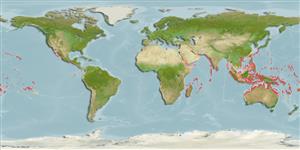Common names from other countries
Environment: milieu / climate zone / depth range / distribution range
Écologie
marin récifal; profondeur 0 - 20 m (Ref. 9770). Tropical; 30°N - 32°S
Indo-Pacific: Red Sea south to East Africa through Indonesia and northern Australia up to Hawaii and Pitcairn islands; north to southern Japan.
Taille / Poids / Âge
Maturity: Lm ? range ? - ? cm
Max length : 30.0 cm TL mâle / non sexé; (Ref. 30573)
Épines dorsales (Total): 3; Rayons mous dorsaux (Total): 22-25; Épines anales 0; Rayons mous anaux: 20 - 22. Body orange-brown above; head and belly white; soft dorsal, anal and pectoral fins pale; caudal fin dusky (Ref. 4420).
Occur in shallow outer reefs subject to surge (Ref. 9770, 48637). Commonly found over barren rock or the spur-and-groove zone where there is a mixture of bare rock, rubble, and coral. Juveniles on algae reef (Ref. 48637). Benthopelagic (Ref. 58302). Feed on algae, detritus, mollusks, crustaceans, worms, echinoderms, fishes, sponges, foraminiferans, and eggs. Territorial. Oviparous (Ref. 205). Also taken by drive-in nets (Ref. 9770). Minimum depth reported taken from Ref. 128797.
Life cycle and mating behavior
Maturité | Reproduction | Frai | Œufs | Fécondité | Larves
Distinct pairing (Ref. 205).
Matsuura, K., 2001. Balistidae. Triggerfishes. p. 3911-3928. In K.E. Carpenter and V. Niem (eds.) FAO species identification guide for fishery purposes. The living marine resources of the Western Central Pacific. Vol. 6. Bony fishes part 4 (Labridae to Latimeriidae), estuarine crocodiles. FAO, Rome. (Ref. 9770)
Statut dans la liste rouge de l'IUCN (Ref. 130435)
CITES (Ref. 128078)
Not Evaluated
Menace pour l'homme
Harmless
Utilisations par l'homme
Pêcheries: intérêt commercial mineur; Aquarium: Commercial
Plus d'informations
RéférencesAquacultureProfil d'aquacultureSouchesGénétiqueElectrophoresesHéritabilitéPathologiesTraitementMass conversion
Outils
Articles particuliers
Télécharger en XML
Sources Internet
Estimates based on models
Preferred temperature (Ref.
115969): 24.8 - 29.3, mean 28.3 (based on 2985 cells).
Phylogenetic diversity index (Ref.
82804): PD
50 = 0.5078 [Uniqueness, from 0.5 = low to 2.0 = high].
Bayesian length-weight: a=0.02570 (0.01489 - 0.04438), b=2.92 (2.77 - 3.07), in cm Total Length, based on LWR estimates for this species & (Sub)family-body (Ref.
93245).
Niveau trophique (Ref.
69278): 3.5 ±0.3 se; based on diet studies.
Résilience (Ref.
120179): Milieu, temps minimum de doublement de population : 1,4 à 4,4 années (Preliminary K or Fecundity.).
Fishing Vulnerability (Ref.
59153): Low vulnerability (20 of 100).
